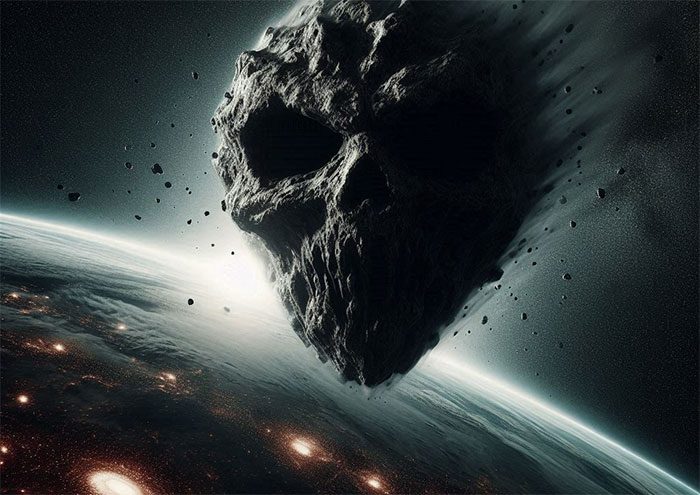A new study suggests that planetary defense strategies should not overlook a peculiar and highly unstable type of object, nicknamed “dark comet.”
“Dark comet” is the nickname given by scientists to a number of strange cosmic objects recently discovered, which exist half like asteroids and half like comets.
A study recently published in the scientific journal Icarus indicates that “dark comets” are not only peculiar but also much more dangerous than we previously thought.

A type of hybrid object between comets and asteroids could be a terrifying threat to Earth – (AI Image: Anh Thư).
Typically, comets are quite distinct from asteroids.
Comets originate from the outer regions of the Solar System, having stable orbits that are occasionally perturbed by gravitational interactions with the giant planets, moving toward the Sun where they gradually disintegrate due to its intense heat. This process creates their ethereal tails.
In contrast, asteroids usually reside in the “inner Solar System”, primarily between Mars and Jupiter.
They are much harder than comets, allowing them to survive longer in the vicinity of the Sun. Occasionally, they also enter unstable orbits, approaching or even colliding with Earth.
“Dark comets,” recently identified, exhibit a peculiar third state.
This type of object is small, with a maximum diameter of only a few tens of kilometers. Unlike comets, they do not show visible outgassing or sublimation of volatile elements like water.
They also do not move in perfect orbits. They exhibit evidence of non-gravitational acceleration—implying that some other forces are gently nudging their orbits in unusual ways.
All small objects in our solar system, including asteroids, experience some degree of non-gravitational acceleration, but astronomers can usually identify the cause.
For instance, asteroids heated unevenly by the Sun experience slight but measurable shifts in their orbits.
However, the non-gravitational acceleration of dark comets does not align with uneven heating, suggesting that some “force” is acting on them. An invisible outgassing “mimicking” that of comets could contribute.
The team, led by researcher Aster G. Taylor from the Michigan Institute of Exploration and Computational Engineering, suspects that dark comets may originate from the asteroid belt between Mars and Jupiter but become unstable due to interactions with Saturn.
Moreover, they are a special type of asteroid containing a large amount of light-reflecting molecules, such as water.
Their unstable orbits and uncertain combination of characteristics make them particularly dangerous near-Earth objects. They are small, fast, difficult to detect, and challenging to predict in their paths.
Thus, they could cause completely unexpected Earth strikes.
It is possible they have struck before: The characteristics of “dark comets” suggest that this lineage may be the space objects that once repeatedly collided with primordial Earth, bringing the first water-rich molecules that provided Earth with water and, consequently, life.
Regardless, in the present, they pose a danger. Scientists believe it is crucial to further clarify the origins of these types of objects to design more appropriate measures to guard against sudden impacts.


















































